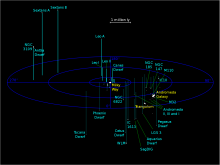Listen to today's episode of StarDate on the web the same day it airs in high-quality streaming audio without any extra ads or announcements. Choose a $8 one-month pass, or listen every day for a year for just $30.
You are here
Heading North
While the Moon orbits Earth and Earth orbits the Sun, the Sun isn’t exactly standing still. In fact, it’s racing around the center of the Milky Way galaxy, carrying Earth and the other planets with it.
The solar system inhabits the most luminous part of the Milky Way: its disk, which includes the beautiful spiral arms and most of the galaxy’s stars. It’s shaped like a pancake, except this pancake is enormous: at least a hundred thousand light-years across and a couple of thousand light-years thick.
We’re about 27,000 light-years from the galaxy’s center — nearly halfway to the edge of the disk. And we’re near the midplane of the disk — the line that divides it into northern and southern halves. Estimates vary, but the solar system is probably between 40 and 90 light-years north of the midplane. That’s not very far when compared to the thickness of the disk.
Still, with every passing minute, we’re moving higher. As the Sun orbits the galactic center, it slowly bobs up and down, like a horse on a merry-go-round. And for millions of years, we’ve been moving up. Eventually, we’ll reach a peak altitude and start to head back down. But we’ll never venture beyond the bounds of the Milky Way’s starry disk.
And under dark skies, that disk is visible as the hazy band of light known as the Milky Way. It’s quite low in the sky this evening, but arcs high overhead before dawn tomorrow. It’ll be in better view in the evening sky as we head into summer.
Script by Ken Croswell, Copyright 2017






